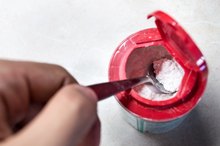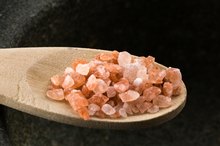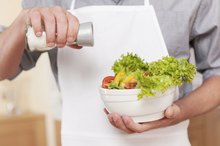Sodium Chloride and Digestion
You may know that sodium is a mineral you need to maintain cellular health and well being – in fact, so is chloride. Table salt, or sodium chloride, is a source of both these essential minerals. You use sodium and chloride in the process of digesting other compounds, as well as elsewhere in the body.
Sodium
Sodium is a metallic element, but you won't encounter pure metallic sodium in nature because it's very reactive. Instead, sodium occurs in nature in the form of various salts. These are compounds of positively-charged particles of sodium chemically combined with negatively-charged particles of other elements or compounds. One common sodium salt is sodium chloride; other common sodium salts include sodium bicarbonate, which is baking soda, and sodium hydroxide, or lye.
Chloride
Bicarbonate of Soda Vs. Sodium Chloride
Learn More
Chloride is the chemical name for negatively-charged particles of chlorine, which is an element. You don't generally encounter elemental chlorine – a toxic green gas – in nature, though you'll often find chloride in compounds. Aside from sodium chloride, perhaps the most well recognized of the chloride compounds is hydrochloric acid, or HCl. This is a common industrial acid and is the acid produced by cells in your stomach.
Digestion of Food
Though you don't need to digest sodium chloride that you consume, sodium and chloride in your body help you to digest and absorb the nutrients you eat. Though you depend in great part upon digestive enzymes to help you break down your food, stomach acid is also important to the process of digestion. You need chloride in your bloodstream to produce the HCl secreted by stomach cells, explains Dr. Lauralee Sherwood in her book "Human Physiology."
Absorption
Natural Source of Calcium Carbonate
Learn More
The sodium from sodium chloride and other sources is critical to your ability to absorb monosaccharides and amino acids – the building blocks of carbohydrates and proteins, respectively – from the small intestine into your bloodstream. When you consume carbohydrates and proteins, you digest them into their building blocks. The intestinal cells then move them into the bloodstream. This process requires the presence of sodium, since sodium activates the transporter proteins that shuttle the building blocks across the intestinal lining, explains Dr. Gary Thibodeau in his book "Anatomy and Physiology."
Related Articles
References
- “Human Physiology”; Lauralee Sherwood, Ph.D.; 2004
- “Anatomy and Physiology”; Gary Thibodeau, Ph.D.; 2007
- “Biochemistry”; Reginald Garrett, Ph.D. and Charles Grisham, Ph.D.; 2007
Writer Bio
Kirstin Hendrickson is a writer, teacher, coach, athlete and author of the textbook "Chemistry In The World." She's been teaching and writing about health, wellness and nutrition for more than 10 years. She has a Bachelor of Science in zoology, a Bachelor of Science in psychology, a Master of Science in chemistry and a doctoral degree in bioorganic chemistry.









